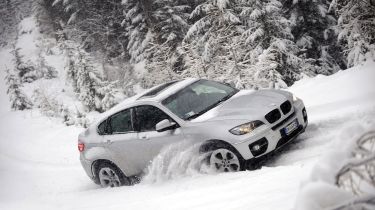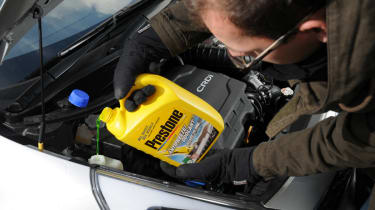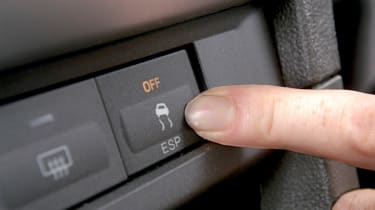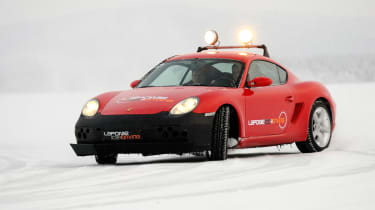Driving in the snow can be risky. These top tips will keep you safe when the roads are blanketed with the white stuff
During most winters, snow manages to bring many of the UK’s main roads to a halt, not just because the asphalt is buried in the stuff, but also because lots of people simply just don’t know how to drive in snow. Don’t worry though, because here we outline the basics of driving in snow, ice, and everything else winter has to throw at the UK driver.
It goes without saying that if you are driving in snow you need to be more prepared than when driving in the blazing sunshine; get stuck in sub-zero temperatures at the side of the road without a thick coat and a blanket and you will soon learn why. Not only this, but as the snow on the ground increases, so does the likelihood of you having an accident, so car journeys are best undertaken only when absolutely necessary.
How to drive on ice: top tips
If you have the ability to work from home, it makes good sense to do so when the weather has taken a turn for the worse. Plenty of offices now have remote working that means you don’t have to risk life and limb to get to your place of work. Of course, when a job requires you to be at a location, then you need to see if you can make alternative plans.
If you feel that you must drive, then plan your journey using main roads. These routes are more likely to have been gritted and cleared by the local authorities. In this instance, it will be better to stick with the traffic than take a chance on untreated back roads, and it means you will be easier to get to if you break down or have an accident.
Of course, with snow comes ice, and you will need to drive gently if you are to make good progress without your wheels spinning away in a blur of motionless fury. When pulling away from a standstill in a car with a manual gearbox, you can use second gear to boost traction. Revving an engine hard means you’re sending lots of power to the driving wheels, and using a higher gear means lower revs, which won’t overwhelm the tyres so easily.
Best winter tyres 2021: tyre brands reviewed and UK prices compared
Once you’re moving, it’s best to maintain your momentum, since coming to a stop could cause you to get stuck. But go too fast and you could easily lose control. Keep an extra-large distance between you and the car in front and look as far ahead as possible so that you are prepared to slow down with plenty of space and time to do so.
That’s the basics sorted, while below we’ve got 10 top tips to help you through the trickiest of conditions.
Top 10 tips for driving in snow
Be prepared
Plan for the worst. Make sure you’ve got warm clothes, a rug, a torch, a snow shovel and maybe some emergency food. Also, make sure your phone is fully charged before setting off or even have a cheap mobile phone charged and ready to go in the glovebox just in case. Also wear decent driving shoes – driving in snow boots or wellies is a bad idea because it’s harder to feel the pedals under your feet. One strong recommendation we would give is to get your car fitted with winter tyres ahead of the cold weather. Once the temperature gets into single figures, then that’s when you should get them fitted.
Be smooth
When you’re driving, avoid sudden applications of the throttle, brakes and steering. If you’re struggling for traction, don’t accelerate excessively – spinning the wheels will only make things worse. Try using second gear to gain grip when pulling away and try to feel grip by slipping the clutch. Some automatic gearboxes will offer a winter mode.
Brake smoothly
When driving on snow-covered slopes, keep the speed slow at the top of the hill. It’s easier to maintain a steady speed than slow down on the descent. Leave big braking distances to vehicles in front – apply the brake pedal gently and avoid triggering the ABS, because the system can struggle to cope if conditions are very slippery. Older cars without ABS may stop sooner, thanks to the locked wheels causing a snowplough effect, in which snow builds up in front of them.
See and be seen
When you start your car, give it plenty of time to warm up, and clear all the snow and ice from your windows and lights – not doing so could be deemed as a traffic offence by the police. If there’s a lot of snow on the roof, this should be cleaned off, too, because if it falls off while you’re driving it could cause a hazard for other motorists. Ensure your screenwash isn’t frozen and your wipers aren’t stuck to your windows. When you’re driving, make sure your headlights are on and can be seen by other drivers.
Always plan ahead
Turn your radio on to hear the latest traffic and weather reports, and try to tune into a local station that will have more specific information on your part of the country. Conditions may not be too bad when you set off, but check ahead for your journey, too. If you don’t have winter tyres, try to avoid routes that have steep inclines and stick to main roads, which are more likely to have been treated.
Know your car’s safety systems
If you’ve got ESP, the stability control element will help you in a slide. But traction control can sometimes make it hard to get moving in heavy snow. Most cars will allow you to turn off the traction element of the stability control. If you have an auto box, check whether you have a winter mode.
What is ESP, and ESC on a car?
Don’t panic in a slide
If the front wheels start to push across the road, don’t crank on more lock. Ease off the throttle and straighten the steering for a moment to allow the tyres to regain grip. If the rear of the car starts to drift, steer into the slide – known as applying opposite lock. Always look where you want the car to go, because this will help you go in the right direction. Avoid standing on the brakes, because this will only further upset the car, possibly causing you to spin.
Anticipation
In snowy and icy conditions, it takes longer to stop and turn, so reduce your speed and leave lots of extra room to the car in front. Watch out for cars around you that may be sliding or losing control. Snow-covered signs and obscured kerbs mean you should pay extra attention to the road infrastructure.
Invest in a course
Nothing takes away the fear of driving in snow more than experiencing it in a controlled environment with expert tuition. Winter driving courses in the Arctic are not cheap, but great fun, and you’ll come away with a host of new skills. If you’re on a tighter budget, a skid-control course based on a wet track or in a car that’s fitted to a skid rig is worth doing.
Getting stuck
If you get stuck in snow and are forced to abandon your car, try to move it as far off the road as possible so that you don’t block the way for drivers who are able to continue. If the car starts to slide back down an incline, crank the steering to full lock and apply the handbrake – this will lock the rear wheels, while the fronts will build a bank of snow like a plough, slowing your descent.
What are your top tips for driving in winter weather? Let us know in the comments section below…
Best winter cars
| • Best electric SUVS to buy now | • Best SUVs to buy now |
| • Best crossovers to buy now | • Best small 4x4s to buy now |
Get ready for winter on the roads
| • Winter tyre test | • All-season tyre test |
| • Best car tyres to buy now | • Snow chains in the UK: do you need them? |
| • Winter car checklist and best buys | • How to avoid a flat car battery |
| • How to store your car over winter | • The world’s coldest roads |
Top tips for winter driving
| • What is aquaplaning and how to avoid it | • How to drive in rain and floods |
| • How to drive on ice | • How to drive in snow |
| • How to control skids | • How to use ABS brakes |
| • What is ESC or ESP? | • How to jump start your car |
Source: Read Full Article


 How to drive on ice: top tips
How to drive on ice: top tips Best winter tyres 2021: tyre brands reviewed and UK prices compared
Best winter tyres 2021: tyre brands reviewed and UK prices compared

 What is ESP, and ESC on a car?
What is ESP, and ESC on a car?